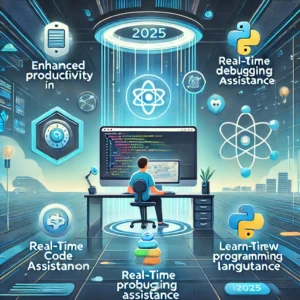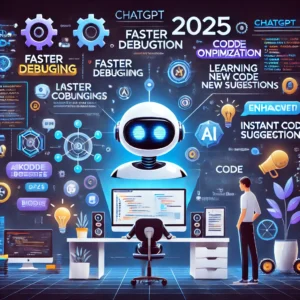How to Use ChatGPT for Coding in 2025 Introduction
In 2025, artificial intelligence (AI) continues to revolutionize the way developers code, troubleshoot, and innovate. Among the most powerful AI tools available today is ChatGPT—a conversational AI developed by OpenAI. ChatGPT is not just a chatbot; it’s a versatile tool capable of assisting with coding tasks, solving complex problems, and boosting productivity for developers of all skill levels. Whether you’re a seasoned coder or just starting your programming journey, ChatGPT can significantly streamline your workflow.
In this article, we’ll explore how to effectively use ChatGPT for coding in 2025. We’ll cover its features, benefits, limitations, and practical tips for making the most of this AI-powered tool.

Why Use ChatGPT for Coding?
ChatGPT offers several advantages that make it an essential tool for modern developers:
- Code Assistance:
- Write, debug, and optimize code efficiently.
- Support for multiple programming languages, including Python, JavaScript, Java, C++, and more.
- Learning and Skill Development:
- Generate explanations for complex coding concepts.
- Provide beginner-friendly tutorials and examples.
- Problem Solving:
- Help identify errors and suggest fixes.
- Offer algorithmic solutions and logic suggestions.
- Time Efficiency:
- Automate repetitive coding tasks.
- Generate templates and boilerplate code quickly.
How to Use ChatGPT for Coding in 2025
1. Getting Started with ChatGPT
- Sign Up: Create an OpenAI account if you don’t already have one.
- Choose a Plan: Depending on your needs, you can opt for free or premium plans, which may offer faster response times and enhanced features.
- Integrate Tools: Use IDE plugins or APIs to incorporate ChatGPT directly into your development environment.
2. Writing Code
ChatGPT can help you write code snippets, full programs, or even pseudo-code. Here’s how:
- Ask Directly: Provide clear instructions, such as, “Write a Python function to calculate Fibonacci numbers.”
- Generate Boilerplate Code: Ask ChatGPT to create templates for web development, APIs, or machine learning models.
- Optimize Code: Input your code and request improvements for better efficiency or readability.
3. Debugging Code
Debugging is a time-consuming task, but ChatGPT can make it easier:
- Error Analysis: Copy-paste error messages and ask for possible causes and solutions.
- Code Review: Provide your code and ask for suggestions on improving logic, fixing bugs, or adhering to best practices.
- Automated Testing: Request ChatGPT to generate test cases for your functions or programs.
4. Learning New Technologies
ChatGPT is a great companion for exploring new programming languages or frameworks:
- Interactive Tutorials: Request step-by-step guides, such as, “Teach me the basics of Rust programming.”
- Hands-On Examples: Generate example code for technologies like React, Flask, or TensorFlow.
- Concept Clarifications: Ask for explanations of topics like “What is polymorphism in object-oriented programming?”
5. Building Projects
From idea to implementation, ChatGPT can assist:
- Project Planning: Ask for project outlines or feature suggestions.
- Implementation Help: Break down tasks into smaller coding milestones.
- Code Refactoring: Submit your project files and request improvements for performance or readability.

Benefits of Using ChatGPT for Coding
- Increased Productivity: ChatGPT handles mundane and repetitive tasks, allowing developers to focus on complex challenges.
- Accessibility: Whether you’re a beginner or an expert, ChatGPT adapts to your skill level, providing relevant help.
- Language Support: ChatGPT supports multiple programming languages, making it a one-stop solution for diverse development needs.
- Collaborative Learning: Developers can use ChatGPT as a coding partner, brainstorming ideas and debugging collaboratively.
- Scalability: Freelancers, startups, and enterprises alike can use ChatGPT to scale their development processes efficiently.

Challenges and Limitations
While ChatGPT is a powerful tool, it has certain limitations:
- Dependence on Input Clarity: ChatGPT’s effectiveness depends on how clearly you phrase your requests. Vague queries may result in incorrect or irrelevant responses.
- Not Always Accurate: ChatGPT may occasionally provide incorrect code or logic, so always review the output carefully.
- Lack of Real-Time Debugging: Unlike traditional debugging tools, ChatGPT doesn’t directly interface with your code in real-time.
- Privacy Concerns: Sharing sensitive code or data may pose security risks. Avoid uploading proprietary or confidential information.
Best Practices for Using ChatGPT Effectively
- Be Specific: Clearly define your problem or request, e.g., “Write a SQL query to fetch employee data by department.”
- Iterative Approach: Refine your queries based on ChatGPT’s responses to get better results.
- Combine with Traditional Tools: Use ChatGPT alongside IDEs, debugging tools, and version control systems.
- Fact-Check Output: Verify code accuracy and logic before implementing it into your projects.
- Experiment and Learn: Explore ChatGPT’s capabilities by experimenting with different types of requests.
FAQs
Q: What programming languages does ChatGPT support?
A: ChatGPT supports multiple languages, including Python, JavaScript, Java, C++, Ruby, and more.
Q: Can ChatGPT replace traditional IDEs?
A: No, ChatGPT complements IDEs by providing code assistance, debugging help, and learning resources but doesn’t replace them.
Q: Is ChatGPT suitable for beginners?
A: Absolutely! ChatGPT simplifies complex concepts and provides beginner-friendly tutorials and examples.
Q: How secure is ChatGPT for coding?
A: While ChatGPT is a helpful tool, avoid sharing sensitive or proprietary information to ensure security.
Q: Is ChatGPT free for coding tasks?
A: ChatGPT offers free access with limited features, while premium plans provide enhanced capabilities and faster response times.